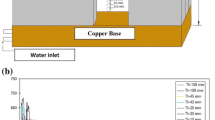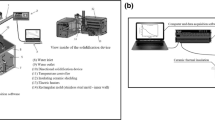Abstract
Dimensional changes and creep deformation of a silica/zircon (74%/24%, respectively) and a high silica (93% silica and 3% zircon) ceramic were characterized and compared. All specimens were tested with a thermal profile that consisted of a 300°C/h heating rate to 1475 or 1525°C, followed by a one-hour isothermal hold (where each specimen was compressively crept under a static stress of 2.07, 4.14, or 6.21 MPa). The specimens were cooled at a rate of 900°C/h under stress. Dimensional changes were interpreted from apparent thermal expansion behavior during heating as well as before-and-after dimensional measurements. The silica/zircon ceramic generally exhibited less total contraction than the high silica ceramic for a specific test condition even though it crept faster at all stresses and temperatures during the one-hour isothermal/isostress segment. This indicates that the total contraction for both was dominated by reinitiated sintering and subsequent cristobalite formation that occurred during the heating segment. Minimum creep rate during the one-hour isothermal/isostress segment was examined as a function of stress and temperature for both ceramics using a power-law creep model. Creep-rate stress exponents (n) and activation energies (Q) were equivalent (within 95% confidence) for both ceramics showing that their different contents of zircon (3 vs. 24%) did not affect them. Lastly, n ≈ 1.3–1.4 and Q ≈ 170 kJ/mol indicate that diffusion-assisted crystallization of cristobalite, combined with power-law sintering owing to the high concentration of porosity (28–30%) was likely the rate-limiting mechanism in the creep deformation for both ceramics.
Similar content being viewed by others
References
E. SACHS, M. CIMA and J. BREDT, in “Intelligent Design and Manufacturing for Prototyping, ” ASME PED-Vol. 50 (1991) p. 61.
S. URAM, Foundry July (1971) 48.
I. C. HUSEBY, M. P. BOROM and C. D. GRESKOVICH, Ceramic Bulletin 58 (1979) 448.
V. ZANDIAN, J. S. FLORRY and D. TAYLOR, British Ceramic Transactions 92 (1993) 155.
L.-Y. WANG and M.-H. HON, Journal of the Ceramic Society of Japan 102 (1994) 517.
Idem., Ceramics International 21 (1995) 187.
“Standard Classification of Silica Refractory Brick, ” ASTM C416, Vol. 15.01 (American Society for Testing and Materials, West Conshohocken, PA, 1998).
S. SHIN and O. BUYUKOZTURK, US DOE Report ORNL/Sub/79-07862/02 (1990).
“Standard Test Method of Measuring the Thermal Expansion and Creep of Refractories Under Load, ” ASTM C832, Vol. 15.01 (American Society for Testing and Materials, West Conshohocken, PA, 1998).
F. H. NORTON, “The Creep of Steel at High Temperature” (McGraw-Hill, New York, 1929).
E. A. PAYZANT and W. S. HARRISON III, Advanced X-Ray Analysis 43 (2000) 267.
H. WANG and E. A. PAYZANT, in Thermosense XXI— Proceedings of SPIE, Vol. 3700, (1999) p. 377.
K. KATO and Y. NOZAKI, Imono 62 (1990) 726.
I. B. CUTLER and R. E. HENRICHSEN, J. Amer. Ceram. Soc. 51 (1968) 604.
W. R. CANNON and T. G. LANGDON, J. Mater. Sci. 18 (1983) p. 1.
H. PALMOUR III and D. R. JOHNSON, in “Sintering and Related Phenomena, ” edited by G. C. Kuczski et al. (Gordon and Breach, New York, 1967) p. 779.
D. S. WILKINSON and M. F. ASHBY, Acta Metallurgica 23 (1975) 1277.
Idem., Science of Sintering 10 (1978) 67.
G. HETHERINGTON, J. H. JACK and J. C. KENNEDY, Physics and Chemistry of Glasses 5 (1964) 130.
F. E. WAGSTAFF, J. Amer. Ceram. Soc. 52 (1969) 650.
T. TAKAYANAGI and S. KATASHIMA, Imono 60 (1988) 401.
Author information
Authors and Affiliations
Rights and permissions
About this article
Cite this article
Wereszczak, A.A., Breder, K., Ferber, M.K. et al. Dimensional changes and creep of silica core ceramics used in investment casting of superalloys. Journal of Materials Science 37, 4235–4245 (2002). https://doi.org/10.1023/A:1020060508311
Issue Date:
DOI: https://doi.org/10.1023/A:1020060508311




